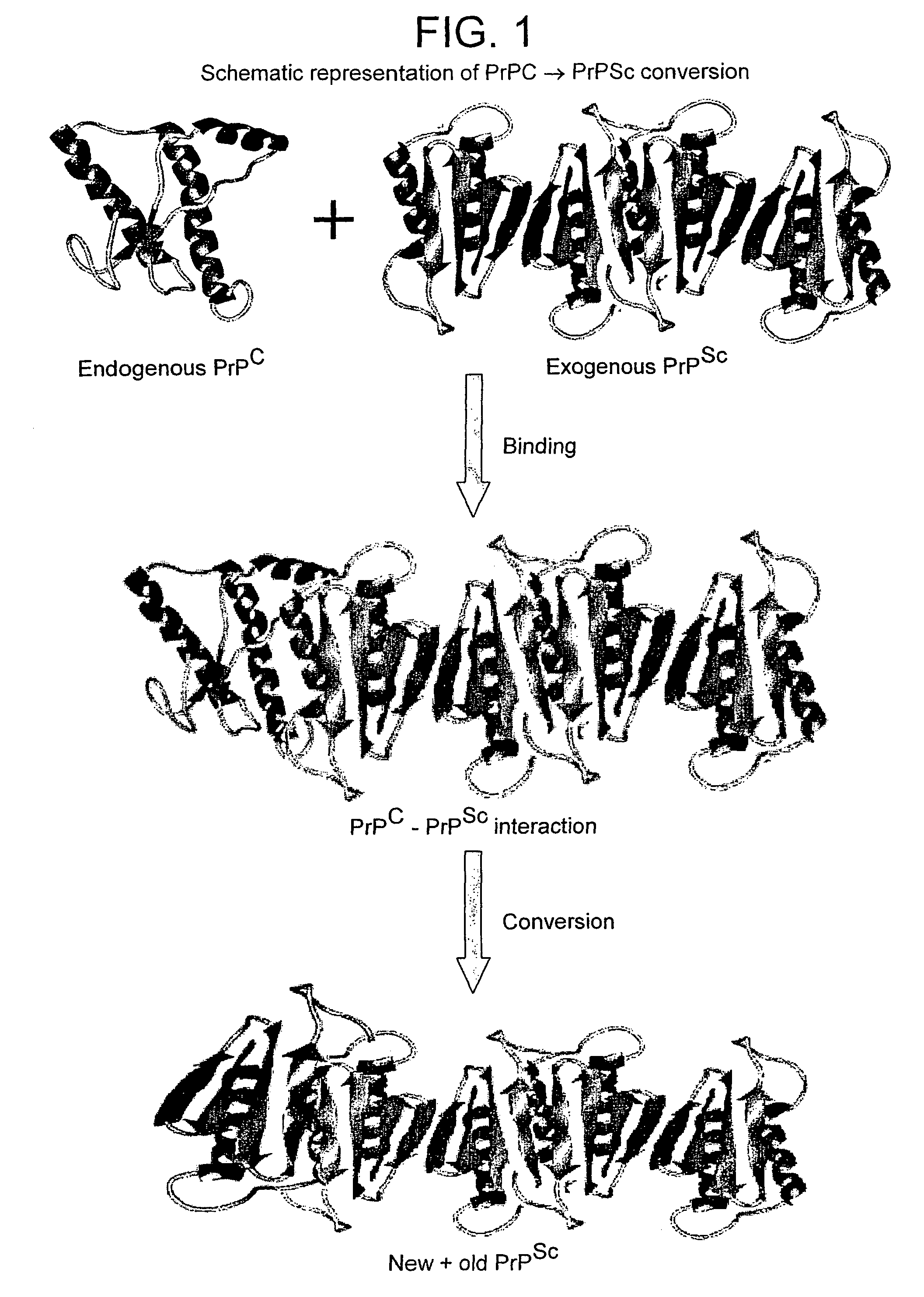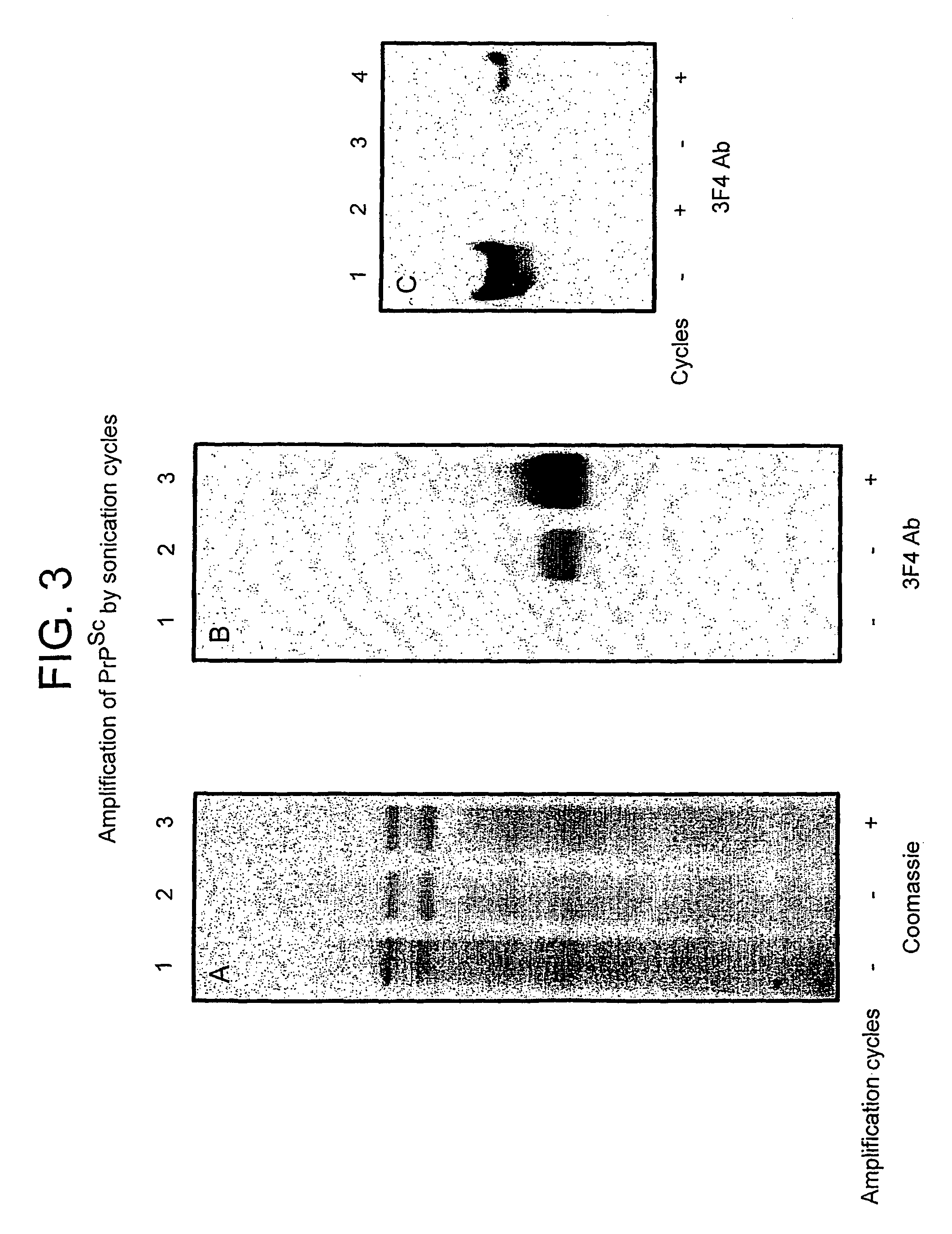Early diagnosis of conformational diseases
a conformational disease and early diagnosis technology, applied in the direction of instruments, peptide/protein ingredients, drug compositions, etc., can solve the problems of lack of immune response, hampered attempts to develop a diagnostic test for prion diseases, and no therapy availabl
- Summary
- Abstract
- Description
- Claims
- Application Information
AI Technical Summary
Benefits of technology
Problems solved by technology
Method used
Image
Examples
example 1
Amplification of PK Resistant PrP by Cyclic in vitro Conversion
[0148]Hamster brain homogenate extracted from scrapie affected animals was diluted until the signal of PrPSc was barely detected by immunoblot after treatment with proteinase K (PK) FIG. 3B, lane 1). PK treatment is done routinely in the field to distinguish between the normal and abnormal forms of PrP, which differ in their sensitivity to protease degradation (PrPSc is partially resistant and PrPC is degraded) (Prusiner, 1991). The form of PrP that is resistant to PK treatment will be named from now on PrPres. Incubation of a sample of diluted scrapie brain homogenate with a healthy hamster brain homogenate containing an excess of PrPC, resulted in the increase in PrPres signal (FIG. 3B, lane 2).
[0149]This suggests that the incubation of the two brain homogenates resulted in the conversion of PrPC to PrPSc. When the samples were incubated under the same conditions but subjected to five cycles of incubation / sonication, t...
example 2
Sensitivity of Detection by Cyclic Amplification
[0151]To evaluate the minimum concentration of PrPSc that can be used for detection after amplification, the scrapie brain homogenate was serially diluted directly in healthy hamster brain homogenate. Without incubation, the signal of PrPres diminishes progressively until it was completely undetectable at 800-fold dilution (FIGS. 4A, C). In contrast when the same dilution was incubated with healthy hamster brain homogenate and subjected to 5 cycles of incubation / sonication, the limit of PrPres detection was decreased dramatically. Indeed, clear signal was easily detected even at a 3200-fold dilution (FIGS. 4B, C).
example 3
Exponential Increase in PrPres with Number of Cycles
[0152]To study whether the intensity of the PrPres signal after cyclic amplification depends on the number of cycles of incubation / sonication performed, diluted scrapie brain homogenate was incubated with an excess of healthy hamster brain homogenate. Samples were subjected to 0, 5, 10, 20 or 40 cycles and the PrPres signal evaluated by immunoblot. The levels of PrPres increased exponentially with the number of incubation / sonication cycles (FIG. 5). This result suggests that increasing the number of cycles could further diminish detection limits.
PUM
| Property | Measurement | Unit |
|---|---|---|
| time | aaaaa | aaaaa |
| time | aaaaa | aaaaa |
| pH | aaaaa | aaaaa |
Abstract
Description
Claims
Application Information
 Login to View More
Login to View More - R&D
- Intellectual Property
- Life Sciences
- Materials
- Tech Scout
- Unparalleled Data Quality
- Higher Quality Content
- 60% Fewer Hallucinations
Browse by: Latest US Patents, China's latest patents, Technical Efficacy Thesaurus, Application Domain, Technology Topic, Popular Technical Reports.
© 2025 PatSnap. All rights reserved.Legal|Privacy policy|Modern Slavery Act Transparency Statement|Sitemap|About US| Contact US: help@patsnap.com



